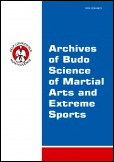2017, Volume 13, Issue 1
Can physical tests predict the technical-tactical performance during official judo competitions?
Rafael Kons1, Jonathan Ache-Dias2, Daniele Detanico1
1Center of Sports, Federal University of Santa Catarina, Florianópolis, Brazil
2Catarinense Federal Institute, Araquari - SC, Brazil
Author for correspondence: Rafael Kons; Center of Sports, Federal University of Santa Catarina, Florianópolis, Brazil; email: rafakons0310[at]gmail.com
Full text
Abstract
Background & Study Aim: Judo is an Olympic sport with an intermittent nature due to the large variety of technical-tactical actions and constant interruptions during competition. Technical-tactical analysis of judo matches may be performed using different indicators. This study aimed is the relationship between generic and judo-specific tests and technical-tactical performance in male judo athletes and to identify the physical variables that may explain the technical-tactical performance.
Materials & Method: Twenty-two judo athletes were evaluated in two stages. First, physical tests − countermovement jump (CMJ), handgrip strength, Special Judo Fitness Test (SJFT), Judogi Grip Endurance Strength Test isometric (JGSTISO) and dynamic (JGSTDIN) − were performed. Second, matches were recorded during competitions for technical-tactical analysis. Pearson’s linear correlation and multiple linear regression analysis were used with the level of significance set at 5%.
Results: The main results showed correlation of the effectiveness index with the number of throws in the second series of SJFT (r = 0.44, p = 0.03) and JGSTISO (r = 0.43, p = 0.04). The number of attacks was correlated to JGSTISO (r = 0.45, p = 0.03) and the effective time was correlated with all kinetic indicators in the CMJ (r = 0.52 to 0.58, p≤0.01). The predictive power and explanation of variance was low for all variables (26-31%).
Conclusions: The athletes with higher isometric endurance grip strength (JGSTISO) performed a higher number of attacks and showed higher effectiveness in competition. Also, the athletes with higher (SJFT) showed higher effectiveness during the matches and the judokas with higher muscle power (CMJ performance) showed higher effective time in the combat bouts. Despite this, only a small part of technical-tactical performance was explained by the physical tests.
Key words: tori, judogi, endurance strength, effectiveness, anaerobic capacity, uke





